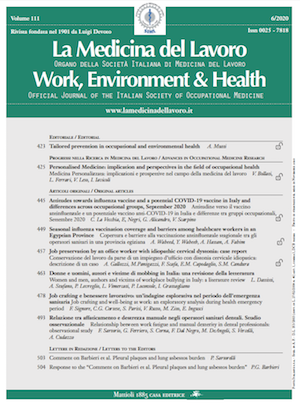Job preservation by an office worker with idiopathic cervical dystonia: case report
Main Article Content
Keywords
Movement disorder; Video display terminal (VDT); Job fitness; Rehabilitation; Ergonomics
Abstract
Background: Work preservation is a main goal in the rehabilitation of chronic disabling diseases. We describe the application of an interdisciplinary protocol, involving the occupational physician, the occupational therapist and the ergonomist, in the case of a 50 year-old office worker with idiopathic cervical dystonia, a movement disorder that can seriously impair work capability. Case report: The disease was diagnosed at age 25, and subsequently worsened. The man presented postural difficulties and pain. The symptomatology worsened during working shifts, preventing him from doing his job properly. Functional evaluation and ergonomic inspection of the office environment led to the correction of evident critical inadequacies. This allowed the patient to continue working in correct conditions, resulting in improvement of his global health status. Conclusions: The interdisciplinary rehabilitative approach here described may allow subjects with idiopathic cervical dystonia to keep their jobs by adapting the workplace to the changed physical capabilities.
References
2. Girach A, Vinagre Aragon A, Zis P: Quality of life in idiopathic dystonia: a systematic review. J Neurol 2019; 266: 2897-2906.
3. Jankovic J, Leder S, Warner D, Schwartz K: Cervical dystonia: clinical findings and associated movement disorders. Neurology 1991; 41: 1088-1091.
4. Molho ES, Stacy M, Gillard P, et al: Impact of cervical dystonia on work productivity: an analysis from a patient registry. Mov Disord Clin Pract 2016; 3: 130-138.
5. Niu S. Ergonomics and occupational safety and health: an ILO perspective. Appl Ergon 2010; 41: 744-753.
6. Riley DS, Barber MS, Kienle GS, et al: CARE guidelines for case reports: explanation and elaboration document. J Clin Epidemiol 2017; 89: 218-235.
7. Rondot P, Marchand MP, Dellatolas G: Spasmodic torticollis – review of 220 patients. Can J Neurol Sci 1991; 18: 143-151.
8. Scafa F, Calsamiglia G, Cadei P, et al: Salute e lavoro dopo procedure invasive cardiache, riabilitazione e valutazione occupazionale: studio prospettico pluriennale. Med Lav 2018; 109: 219-224.
9. Scafa F, Dondi E, Panigazzi M, et al: Work resumption after occupational osteoarticular injury: interdisciplinary protocol and case record. Prevention & Reasearch 2013; 3 :302-308.
10. Skogseid IM, Roislien J, Claussen B, Kerty E: Long-term botulinum toxin treatment increases employment rate in patients with cervical dystonia. Mov Disord 2005; 20: 1604-1609.






